Lampas under Prasnyshem. H. 2
The beginning of the German offensive
From 3 to 6 in February, the Germans daily disturbed the detachment of V. A. Khimets - acting now on Kitka, then on Goodness. Horzhele has a hundred Urals residents dealing with dismounted enemy cavalry.
1. The beginning of the German offensive. Dates - in a new style.
On the night of 6, V. A. Khimets received information about the accumulation of large German forces in Horzhel - and the next morning the whole brigade went to the Křínovlog area. From the region of the last, the battery fired all day at Rembelin, Horjele and Brzeski Kolaki. The Germans answered.
February 7 The 4 Brigade re-entered Krzhinovlyy, and the head of the Turkestan headquarters was instructed "in the event of a serious German offensive to release the shooters into Grudusk."
The battery of the officer artillery school (OAS) bombarded the German columns, moving south from Brzeski Kolaki. Other advancing enemy columns were found on the roads to Prasnysh from Rembelin and from Janów and Khorjele on Krzhinovlog. None restrained from the front, the Germans did not pay attention to the detachment of V. A. Khimets. The head of the detachment, having decided that the cavalry attack on the enemy’s unhappy infantry would only bring casualties, took the 17 brigade to Pavlovo, Chernitsa Borovo to 4 for hours.
In the morning the Germans began shelling the position of Kitki’s shooters. German units appeared on the entire front from Dzerggovko to the Shumsk-Mlava-Galvits road, attacking the 1 Turkestan Corps. As noted by E. Ludendorff, the strike was struck by forces that were three times superior to the Russians (corps: Tsastrova, 17-th reserve, 1-I guards reserve and 3-I infantry divisions - all 6 divisions). In 9 hours, the Germans pressed the Orenburg hundred from Grabovo. The hundred departed in Dzerzhgovo, but in exchange a trot of Koroshnikov was expelled.
By noon, the Germans swept the Ural outposts at Dzerzhgovo, Dobrogosty and Krery, launching an offensive on Brzhozovo. In small groups, the Urals people skipped to Dzerzhgovo - and the whole Turkestan brigade gathered there in 13 hours. The Ural patrol sent for communication from Brzhozovo to Grabovo, captured a German cavalryman on the road from Janov. The latter showed that his regiment was attached to the 1-th reserve corps - and parts of the latter move from Horzhele to Prasnysh.
Until 16 hours, machine gunners continued to fire Germans, acting from Zaboklik heights. At dusk, the team departed in Pavlovo, but there was a regiment of OKSH, and the Turkestans spent the night in Vengra.
The Turkestan reconnaissance had the most important operational and strategic importance: the seriousness and power of the German offensive was revealed, its directions were clarified, and a new (1 st reserve) corps was found. In this case, the horsemen managed to delay (as far as possible) the frontal attack of the enemy.
Thus, already at the very beginning of the Second Prasnyshka operation, the Russian cavalry achieved something, while the German cavalry did nothing: the von Hollen corps was modestly hiding in the rear. E. Ludendorff, complaining about his ignorance of the situation due to the weak work of air reconnaissance, should not be blamed on “lack of knowledge” aviation: German aviation flew on February 5th over Dzerzhgovo. The Russians dispensed with aviation as well - the cavalry, as noted, carried out a very successful reconnaissance. Unlike the cavalry of the opponent. And if the German 2nd and 4th cavalry divisions were moved from Jorgele to Prasnysh? But ... They spoke of German cavalry, there was even a captured cavalryman, but the German cavalry itself was never seen - until the end of the operation.
On February 7, a brigade of the 4 Don Cossack Division from the 1 Horse Corps was sent to help V. A. Khimets.
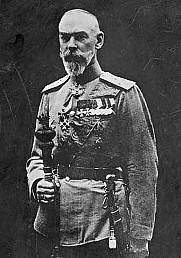
2. The commander of the 4-th Don Cossack Division, Major General M. N. Grabe.
At dawn of 8, the entire squadron V. A. Himets marched to Prasnysh, occupied by the 2-3 battalions of the 66 th Infantry Division with 3-batteries and half-bombs of the Turkestan sapper. Approaching the city, Lieutenant Colonel S. M. Tilicheev, acting chief of staff of 4 th Separate caval brigade, received a report from his patrols - that the Germans were already bending around Prasnysh from the east, and German patrols from Makov approached Prasnysh.
Rising from the 4 Brigade at Venzhevo, V. A. Chimetz sent the Turkestans to Macs. On the road from Kozinje to Venzhevo, parts of the Donets showed up.
Turkestans moved, having in front of a hundred Urals residents, on Romanov - Makov. A departure was made - to Karnevo - Macs. Makov was occupied by four battalions of militias with a hundred border guards and a battery of light guns arr. 1898. The mood of the militias was not bad - despite the armament of the rifle guns and the "antediluvian" guns.
In 16 hours, a hundred Ural residents occupied Mlodzyanovo and entrenched themselves in its northern outskirts. In 18, a Korunzhnik Kadoshnikov’s departure appeared — he was operating between German columns and at Křínovlog for about a day, capturing a volunteer-determined one of the regiments of the 36-th reserve division of the 1-th reserve corps. Moreover, the prisoner diligently carried the duties of the sentinel - under the supervision of the Cossack.
By night, the following information arrived: there were no Germans at Krasnoselts, and the crossing was observed by the 4 Cavalry Division (the core of which was located in Ostrolenka), the crossings at Podosye and Leng occupied by small German infantry units.
In 16 hours V. A. Chimetz went to the area of Karnevo - Helkhi Ilovye.
The result of the work of the Russian cavalry 8 February: completed strategic reconnaissance and identified the left flank of the German offensive, the composition of the German company was established (according to the testimony of the prisoner - from 150 to 170 bayonets).
On the morning of February 9, the SOB battery fired at the grave of Rulera in Krasna (the 2 squadron covered the battery), the Don police conducted reconnaissance west of the Karnevo-Prasnysh road (and together with the 4 brigade gradually moved to the Lukov district), and the Turkestans occupied the Mlodzyanovo line Elzhbetovo - Zalesie - Old one. The corps headquarters telegraphed to the Turkestani: “The proceeds will be tomorrow at noon. I hope for the former energy of the brigade. Cichovich.
Stop the German offensive and the cavalry curtain action.
9 February Prasnysh was lined on all sides (while on the front of Gruduk and west all German attacks were repelled). The right flank of the 1 of the Turkestan Corps was bent and reached to Morgues.
In the morning, from Novogeorgiyevsk, the gallant 1 of the Siberian Army Corps made his way to Karniewo - in order for the third time in half a year to measure strength with a considerably superior opponent. The 2 Siberian Army Corps was concentrated in Ostrolenka to attack Prasnysh. The front command prepared Galvitsu good bag.
On this day, the 4 and Don Brigades were engaged in exchanges of fire and reconnaissance: by the evening, the Don found Germans in Zelen. The entire detachment of V. A. Khimets was pulled together in Lukovo.
The Turkestan brigade for the 14 clocks is located: three hundred Urals from Mlodzyanovo to Elzhbetovo, three hundred Orenburg residents at Helkhi Ilovye and a reserve - two hundred, who covered the community school battery in Malekhi (the Don battery temporarily attached to the brigade was also located there).
The militia squad with the battery stood in the forest near Obetsanovo, while the border guards conducted reconnaissance to the east of the r. Orzhits.
It was decided to keep the exits from the forest belt Poltusk - Karnevo.
From 15 hours, German scouts approached Mlodzyanovo, and in 18 hours a company of infantry approached: a hundred let her steps on 300 - 400 and met with such accurate fire that a company with huge losses rushed into Wengzhinovo.
Around 20 hours between Mlodzyanovo and Bogdankovo German scouts were spotted - patrols were made against them.
The chief of staff of the 2 th Siberian rifle division, Colonel V. I. Mikhailov, wrote in his diary: "... Makov is busy with warriors and 2,5 in the hundreds, who keep well there ...". The evidence of infantry is expensive, for infantry has always been strict in evaluating cavalry units.
On February 11, the squadron of V.Khimets finally split up: its core went to Kolachkovo and from there led the artillery fire on Zelen, and the Turkestans remained in their positions. The enemy did not take active actions until 10 hours, when a hundred of Orenburg people standing in Zalesye noticed an advancing company of Germans. The outskirts of the village was inconvenient for defense, and a hundred retreated to a hillock, from where they met the Germans with fire: they started to fire machine guns from Starovies, and a platoon of equestrians advanced from Elzhbetovo - and the Germans withdrew without accepting the attack.
3. Turkestan brigade 9 - 10 February 1915
The news has come that Prasnysh is holding on. And the Cossacks also decided to stand to the death.
Here it is appropriate to recall the phrase of E. Ludendorff that because “aircraft did not fly” he did not know about the approach to the Russian reinforcements. Blame, of course, not the forces of nature, and their own mistake. But we remembered this because a Russian plane flew over the Turkestanians who had defended themselves.
The shootout flared up ...
The reader may be surprised at the "sluggish" course of action of the German avant-gardes - who did not work the way they were "preached" before the war. But the author, reading the memories of the French dragoon, stumbled upon the following significant phrase: “when German avant-gardes encounter serious resistance, they do not insist, but wait ... and the next day, the Germans turn around, sweeping away everything in their path.”
The German avant-gardes "did not insist," especially since the main forces were occupied by the valiantly resisting Prasnysh.
16 Siberian Division mounted cavalry reconnaissance arrived at Karnevo in 2 hours, and 17 equestrian reconnaissance and division chief of staff Colonel V.I. Mikhailov arrived at 200 for hours. For 480 Cossack rifles, stretched over 10 km, this was a great help, and the fighting reputation of the 1 Siberian Corps left no doubt about the outcome of the upcoming landfill.
V. Khimets, leaving the Don members at Kolachkovo, by the evening moved to Dlugolekka - informing the Germans of the right flank of the Turkestan corps.
With the 19 clock, the avant-garde 2 of the Siberian division appeared, and the Turkestan brigade began to take turns in positions.
At night, she was approached by a 2 train of the rank for the brigade. Cossacks were happy about oatsu almost as well as Siberians.
The results of the cavalry: a) south of Prasnysh, the German advance was stopped, b) west of the city, the use of V. Himets artillery fire also demonstrated the presence of serious forces, and German advancement bypassing the right flank of the 1 of the Turkestan Corps was measured by a very small distance (which was overcome 1-th Guards Reserve and 3-th Infantry Divisions).
The von Hollen's cavalry finally missed the opportunity to prove themselves.
February 10 from Ostrolenka on Krasnoseltsy-Prasnysh was made by the 2 th Siberian corps - its movement was covered from the north by the 4 th cavalry division.
Fight for the initiative.
At about 10 hours of February 11 the drama of the Prasnysh garrison ended. Having lost more than half of his squad from enemy fire, he could not resist the fresh forces that Galvitz pulled up. The sapper staff captain Khanikov was the last to fall - half of which was completely destroyed. On the gravestone inscription of an officer, the Germans who buried him told about this valiant warrior, who fought to the end and did not want to surrender - the captain shot himself under threat of captivity, using the last cartridge of his revolver.
But it was the last success of the Germans.
1 th Siberian Corps turned on the front, which the Cossacks saved him, and launched an offensive - reaching the line Vengzhinovo - Venzhevo by the evening and encircling Red from three sides, in which the Germans firmly settled. The Turkestan Corps beat out the attacks of three times the superior German forces for the third day, while the 2 Siberian Corps approached Krasnoseltsy.
4. The situation under the Prasnyshem. Dates in a new style.
The 4 th cavalry division, under pressure from the enemy, went to N. Vse, and the 39 th Siberian regiment advanced from Ostrolenka to help it.
The Turkestan Cossack Brigade, subordinate to the chief of the 2 Siberian Division, was given the task: to concentrate in front of Lukovo and, in conducting reconnaissance, to provide the left flank of the division.
February 11 for 7 watches it was focused, and 8 combat patrols advanced each 2 hours (each officer, constable and 6 Cossacks): Malenki - Vypihi - Kurevo - Kozin and Milevo Malenki - Bytsy - New All - Zbika Kierzhka.
In 9 hours, hundreds of Urals people with two easel machine guns came out of Lukovo - she had to take Milevo Malenka and move on - depending on the reports of patrols. Under her was the headquarters of the brigade with two "staff" trips. In 9 hours 30 a hundred minutes passed Milevo Malenka - patrols reported that Milevo Byki and Milevo Shveyki are not busy. The brigade made the following leap: a hundred - in Milevo Svejki, the main forces - in Milevo Byki; one hundred of Orenburg citizens is directed to Milevo Ronchka.
In Milevo, Malenka the brigade was overtaken by a patrol of the 15 Hussars, the head of which reported that the whole division was going to Lukovo.
The days were significant for the Turkestan Cossack Brigade.
5. Orenburg Cossacks in equestrian ranks.
To be continued
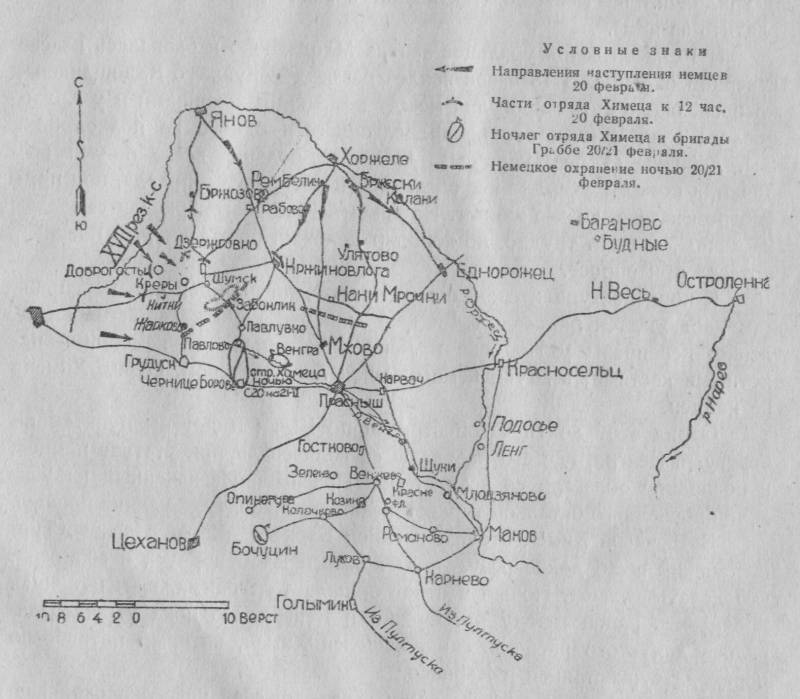
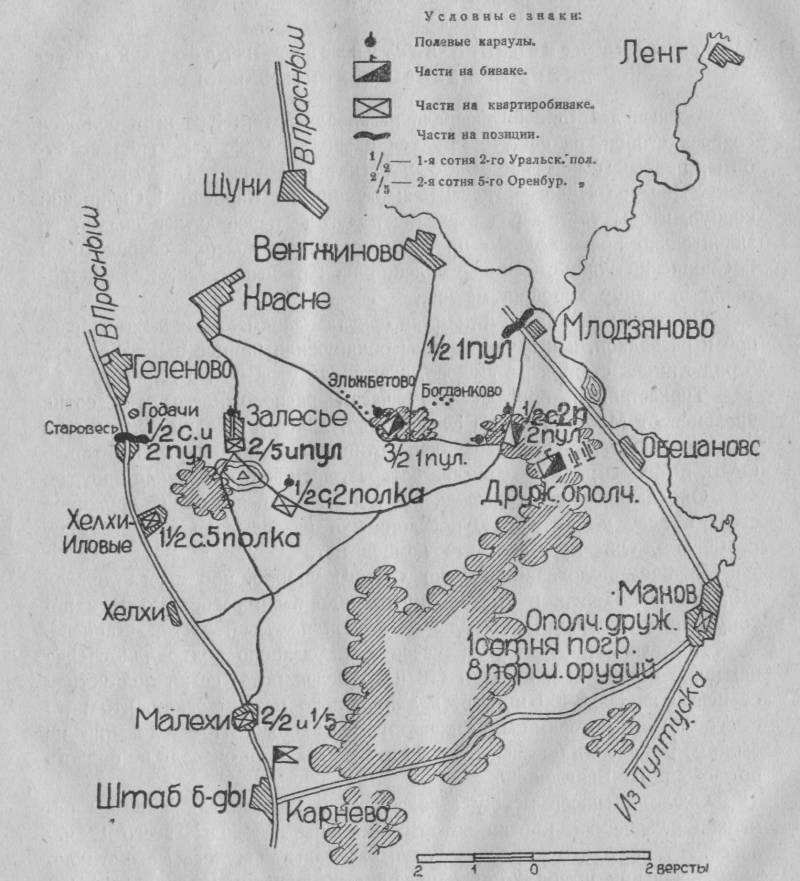
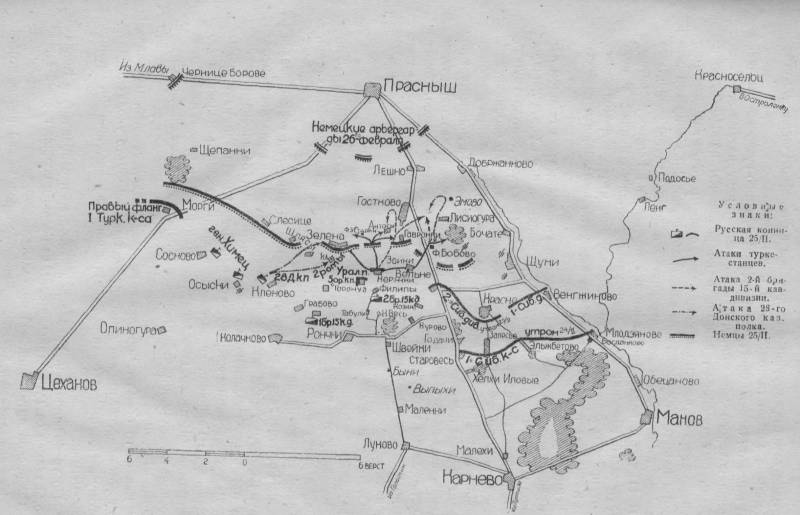
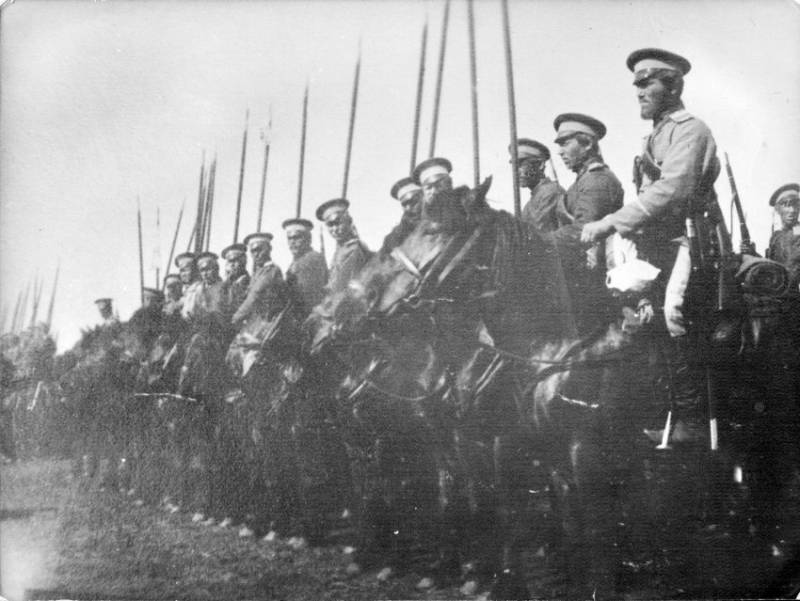
Information